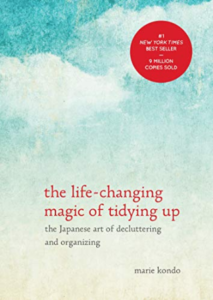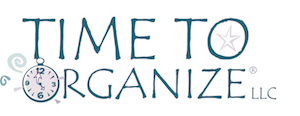A quick answer: Not so much…
 You can’t throw a label maker without hitting Marie Kondo and her “spark joy” method of organizing. She’s everywhere these days, from her best-selling books, The Life-Changing Magic of Tidying Up and Spark Joy: An Illustrated Master Class on the Art of Organizing and Tidying Up, to her new Netflix docuseries, Tidying Up. She’s brought organizing (and professional organizers) into the mainstream spotlight. Not since the show Hoarders has there been this much interest in decluttering.
You can’t throw a label maker without hitting Marie Kondo and her “spark joy” method of organizing. She’s everywhere these days, from her best-selling books, The Life-Changing Magic of Tidying Up and Spark Joy: An Illustrated Master Class on the Art of Organizing and Tidying Up, to her new Netflix docuseries, Tidying Up. She’s brought organizing (and professional organizers) into the mainstream spotlight. Not since the show Hoarders has there been this much interest in decluttering.
As a professional organizer for the past 18 years, I’ve read her books with interest and checked out her show. I am grateful for her enthusiasm for this profession. But some of her techniques don’t quite spark joy in me, and I’m going to share why…
1- Her process ALWAYS starts with clothing. Then she follows with books, papers, and komono (just about everything else). She ends with sentimental items, such as photos and heirlooms. First, off, having a category for “everything else” is a little overwhelming. Secondly, as a professional organizer, my goal is to make improvements in areas that are requested by my clients. If they want to work on clothing, we dive into the master closet. If they want to sort through paperwork or kitchen essentials, we start with that. I have no requirement to start with a particular area, and neither do most of my professional organizing colleagues. Some clients want to organize their entire house. Others just want to tackle one particular area. Whether they want to work with me for three hours or 300, it’s all good.
2- Marie gets her clients started on an area and then leaves. A week later, she visits to check on progress and get them going on the next area. (At least, this is how it is portrayed on the Netflix series.) Most professional organizers would never dream of abandoning their clients at the start of (or at any time during) a project. I will sometimes give “homework” between sessions if a client wants to move forward faster on her own, but that is never a requirement. Most clients need the side-by-side nature of working with a pro organizer.
3- At the start of each area, everything gets dumped out in a big pile so clients can see their items en mass. That means a bed piled high with every single piece of a person’s wardrobe. That means every single book in the entire house piled on the floor. I agree that all items in the category we’re working on should be consolidated into one space. It’s important to gather everything so we can decide what to keep and what to toss. But the “big dump” isn’t for everyone, and there are other ways to gather and sort.
4- She instructs clients to keep only those items that “spark joy.” I’m all for keeping and displaying items that bring joy, but sometimes an item is more of a necessity than a joy-bringer. For example, my kitchen spatulas and whisks don’t exactly make me burst with happiness, but I truly need them to prepare foods. My cat’s litter box isn’t always pleasant, but it’s pretty darn necessary. My box of light bulbs don’t make me do a happy dance, but I’m glad I have them to light the house. You get the point. I direct my clients to keep items that are either beautiful, useful or loved. If anything doesn’t fit one of those categories, then it likely can leave. Items that “spark joy” should be given a place of prominence, in my opinion. Display them lovingly, so you can enjoy them every day.
5- She insists that her clients say “thank-you” to every item they discard. Hmm… I’m all for gratitude, and I encourage my clients to see the abundance in their lives and be thankful. But thanking each out-of-style sweater, stained coffee mug, and stack of paperwork for its service is not part of my organizing repertoire.
6- She spends a lot of time folding stuff. Hey, I’ve folded my share of t-shirts over the years. Probably thousands. But her unique, laborious method that folds items into neat little origami-like packages feels like overkill. Any parent of a toddler (or teenager or husband) will tell you that it takes about 10 seconds to dismantle 30 minutes of careful folding that you arranged neatly in their drawers. Take it from me. Fold quickly, avoid perfection, and move on to things that are more important.
7- There is a lot of emphasis on the decluttering phase. But in the Netflix series, Marie is not very involved in the next steps of the organizing process. After decluttering, I help clients figure out the best place to store their categories of items, find the best containers or storage options, and label bins, shelves, and boxes so that items are stored with intention and found easily in the future. We also discuss tips to maintain the newly neat spaces.
But, there are good things about the KonMari method…
Even though I don’t agree with all of Marie’s techniques, there are many good things about the KonMari method. We learn to organize via category. We learn to keep what we truly love and say goodbye to some items that don’t bring us joy. We learn that beauty and order can make our lives happier. These are all essential concepts, and most professional organizers would agree that they encourage clients to meet these goals. Marie enthusiastically supports her clients and brings the empathy required of a professional organizer. She encourages collaboration between household partners to create homes that are simplified, organized, and lovely.
So with that, I applaud Marie for bringing organization and the concept of “sparking joy” to cluttered households everywhere. If you need a little help bringing order and beauty to your home, I encourage you to contact your local professional organizer!
If you think you might like a career as a professional organizer, please click here to discover some great training resources!
